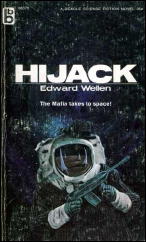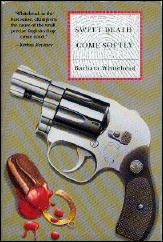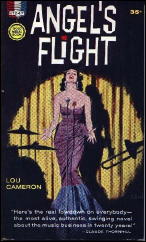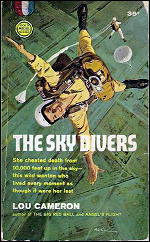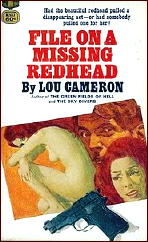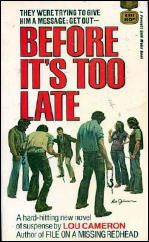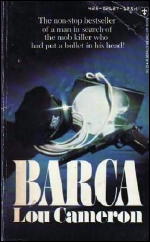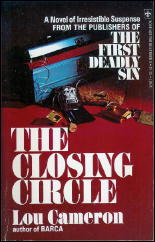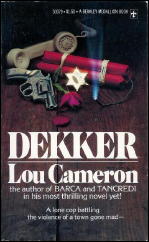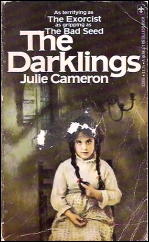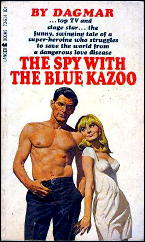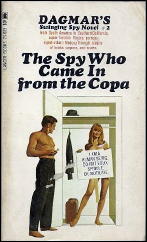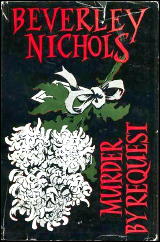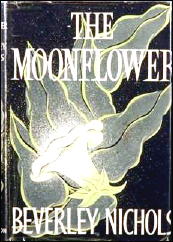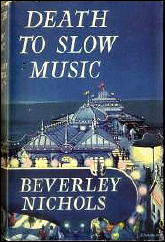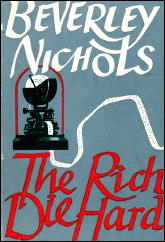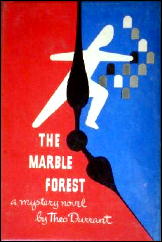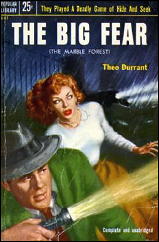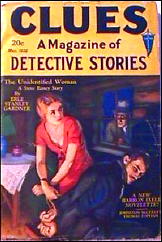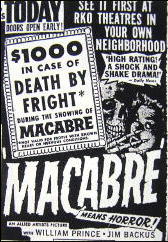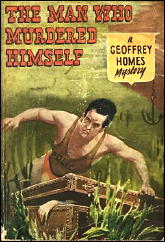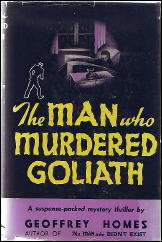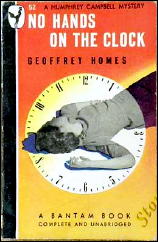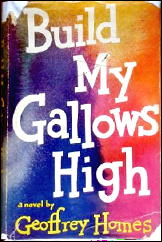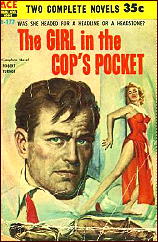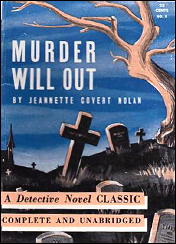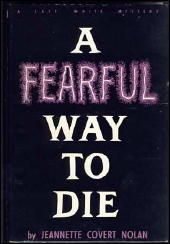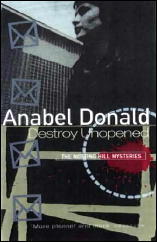SINNING WITH LAWRENCE SANDERS
by George Kelley
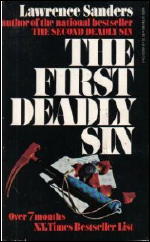
Lawrence Sanders is an inconsistent writer: he can turn out crud like The Pleasures of Helen and Love Songs, then startle readers with powerful novels like The First Deadly Sin (Putnam, 1973; Berkley, 1974), The Second Deadly Sin (Putnam, 1977; Berkley, 1978), and The Sixth Commandment (Putnam, 1979; Berkley 1980).
The First Deadly Sin is a one-on-one contest between a psycho named Daniel Blank and Captain Edward X. Delaney of the New York Police Department. Daniel Blank is obviously named by Sanders to represent a person reaching his limit; here’s how Blank sees the city he lives in:
“It was a city sprung and lurching. It throbbed to a crippled rhythm, celebrated death with insensate glee. Filth pimpled its nightmare streets. The air smelled of ashes. In the schools young children craftily slid heroin into their veins.” (Page10.)
Blank, divorced and alone, meets the fabulously wealthy Celia Montfort. A strange, sick relationship develops to the point where Blank decides he must prove his love to Celia. He does: Blank randomly picks a victim and kills him.
Blank returns to Celia and describes his feelings: “It really was pure. I swear it. It was religious. I was God’s will. I know that sounds insane. But that’s how I felt. Maybe it is mad. A sweet madness. I was God on earth. When I looked at people on shadowed streets Is he the one? Is he the one? My God, the power!” (Page 168.)
The man Blank murdered was Frank Lombard, a Brooklyn city councilman. The politicians of New York scream for vengeance and the inter-departmental maneuvers begin, first to solve the case quickly and reap the glory, later to scapegoat when the random killings continue.
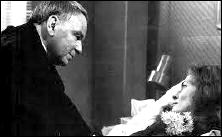
Delaney, asked by a cabal of police officers to quietly investigate the killings while he’s on leave, quickly comes up with important leads. Sanders plays fair with the reader: The First Deadly Sin is a near 600 page book, but the realistic frustration of following leads that turn out to be dead ends, the frustration of developing evidence, produces a long and involved narrative.
The character of Delaney, affectionately called “Iron Balls” by his fellow police officers, is interesting because of his toughness and his passion for order. His method consists of building a mental picture of the murderer, piece by piece:
“Delaney told his men-things like a man’s job, religion, politics, and the way he talked at cocktail parties-these were a facade he created to hold back a hostile world. Hidden were the vital things. The duty of the cops, when necessary, was to peek around the front at the secret urges and driven acts.” (Pages 60-61.)
Blank kills again. And again. Delaney’s mental pictures are still fuzzy. But Blank is slowly losing control: on his job he is aloof and distant. With Celia, with Celia’s brother, Blank’s sex acts become more bizarre. The killings inflame him:
“But when you kill, the gap disappears, the division is gone, you are one with the victim. I don’t suppose you will believe me, but it is so. I assure you it is. The act of killing is an act of love, ultimate love, and though there is no orgasm, no sexual feeling at all-at least in my case-you do, you really do, enter into all humans, all animals, all vegetables, all minerals. In fact, you become one with everything: stars, planets, galaxies, the great darkness beyond, and…” (Page 292).
The eerie picture of Daniel Blank is Sanders’ best writing: convincing and frightening at the same time. If The First Deadly Sin has a major weakness it is its ending. The one-on-one confrontation between Delaney and Blank breaks down and we are left with a drawn-out, frustrating ending.
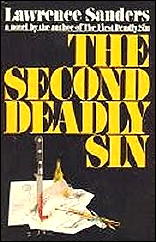
The Second Deadly Sin again features Delaney, but this time he’s drawn out of retirement to track down a murderer of a great painter.
Victor Maitland is stabbed to death and Delaney discovers a dozen suspects who’d like him dead. This is a whodunit, suspenseful and cleverly plotted.
Through the course of the book, it is Delaney, the character of an experienced and ruthless defender of justice, which overshadows the Maitland murder:
“But a cop had to go by Yes or No. Because… well, because there had to be a rock standard, an iron law. A cop went by that and couldn’t allow himself to murmur comfort, pat shoulders, and shake tears from his eyes. This was important, because all those other people — the ruth-givers (sic) — they modified the standard, smoothed the rock, melted the law. But if there was no standard at all, if cops surrendered their task, there would be nothing but modifying, smoothing, melting. All sweet reasonableness. Then society would dissolve into a kind of warm mush: no rock, no iron, and who could live in a world like that. Anarchy. Jungle. (Pages 143-144).
And, in the conclusion, Delaney forces the one-on-one confrontation and dishes out his own kind of justice.
The Sixth Commandment is a strange book. The story is told in the first person by Samuel Todd, an investigator for a philanthropic organization. Dr. Thorndecker, a Nobel Prize winner, asks the organization Todd works for for a million dollar grant to support his research.
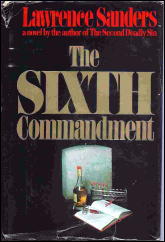
The organization has Todd investigate the Thorndecker proposal. Almost immediately, Todd receives an anonymous note: “Thorndecker kills.” Todd visits the site of the Thorndecker facility near the town of Coburn, north of New York City on the Hudson River. Initially he thinks the note is a con:
“In the groves of academe there’s just as much envy, spite, deceit, connivery, and backbiting as in Hackensack politics. The upper echelons of scientific research are as snaky a pit. The competition for private and federal funding is ruthless. Research scientists rush to publication, sometimes on the strength of palsied evidence. There’s no substitute for being first. Either you’re a discoverer, and your name goes into textbooks, or you’re a plodding replicator, and the Nobel Committee couldn’t care less. (Page 32.)
But Todd finds this isn’t a simple case of jealousy; there’s murder and madness and horror in Coburn beyond Todd’s wildest nightmares.
I recommend all three of Sanders’ books I’ve reviewed here. Sometimes the writing is wooden and dull, sometimes the characters are dull and superficial. But whatever Sanders’ faults, the books move with a power and intensity you should experience.
— Reprinted from The MYSTERY FANcier, Vol. 3, No. 5, Sept-Oct 1979.
Editorial Notes: This article appeared before the film version of The First Deadly Sin was released in 1980. The movie’s two leading co-stars were Frank Sinatra and Faye Dunaway, with David Dukes as Daniel Blank. Other books in the series were The Third Deadly Sin (1981) and The Fourth Deadly Sin (1985).

Other books in the “Commandment” series: Seventh (1991), Eighth (1986), and Tenth (1980). Sanders eventually turned his attention to series character Palm Beach PI Archie McNally, beginning with McNally’s Luck in 1992, although some if not all of the writing is said to have been done by ghostwriter Vincent Gardo.
There were seven in this lighthearted series under Sanders’ byline. When the latter died in 1998, Gardo wrote another five under his own name.
George Kelley’s blog can be found online here, where he finds something interesting to review and talk almost every day.
